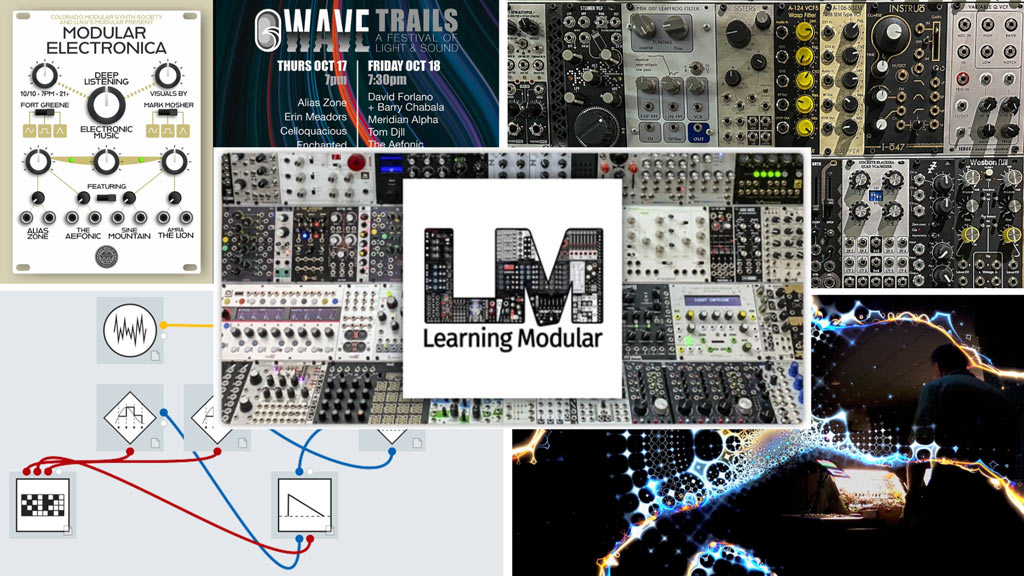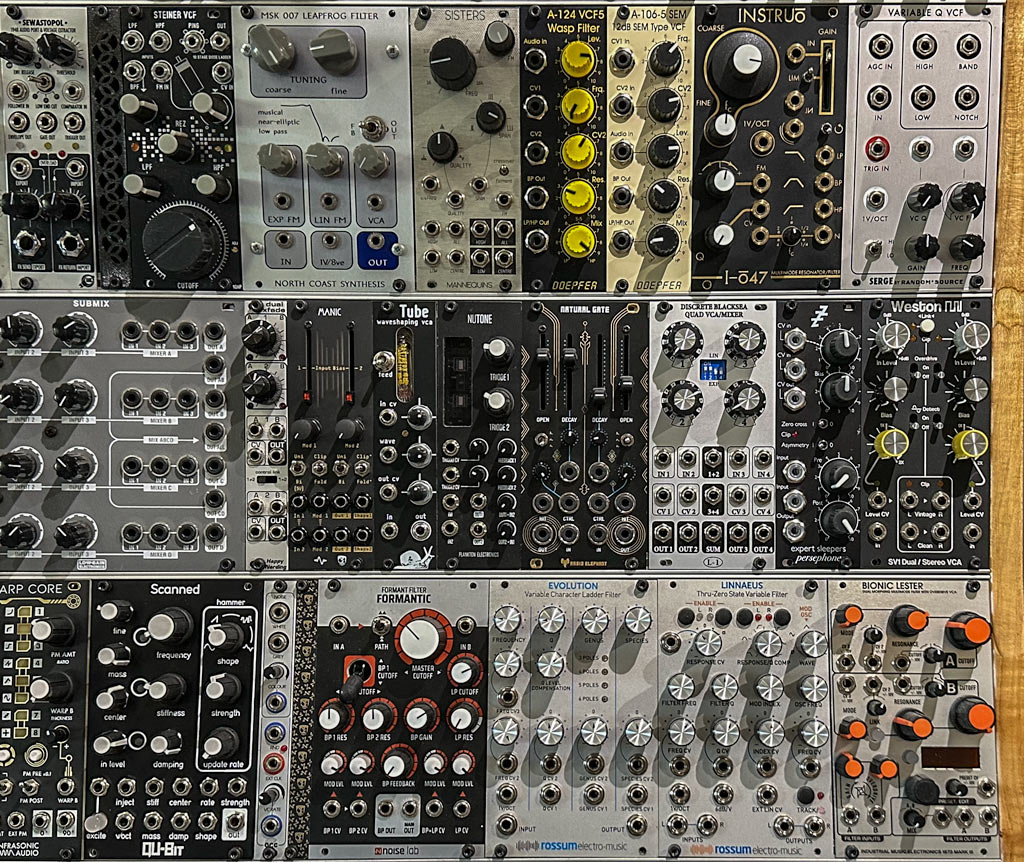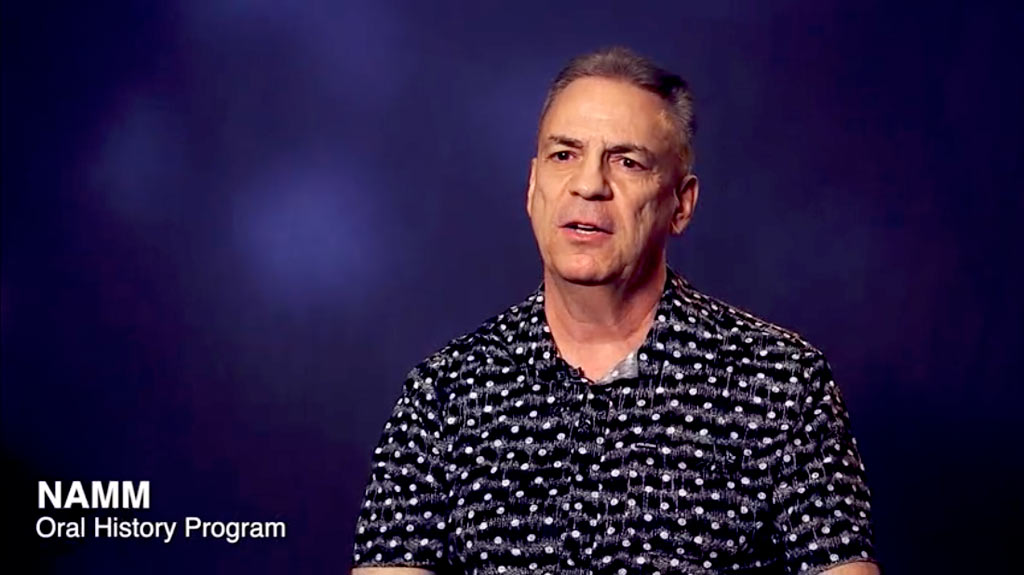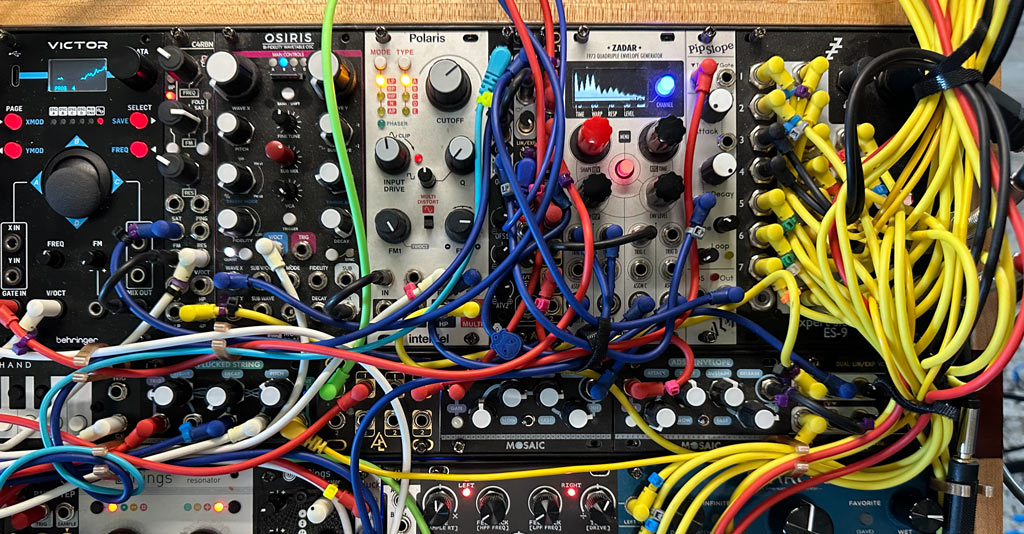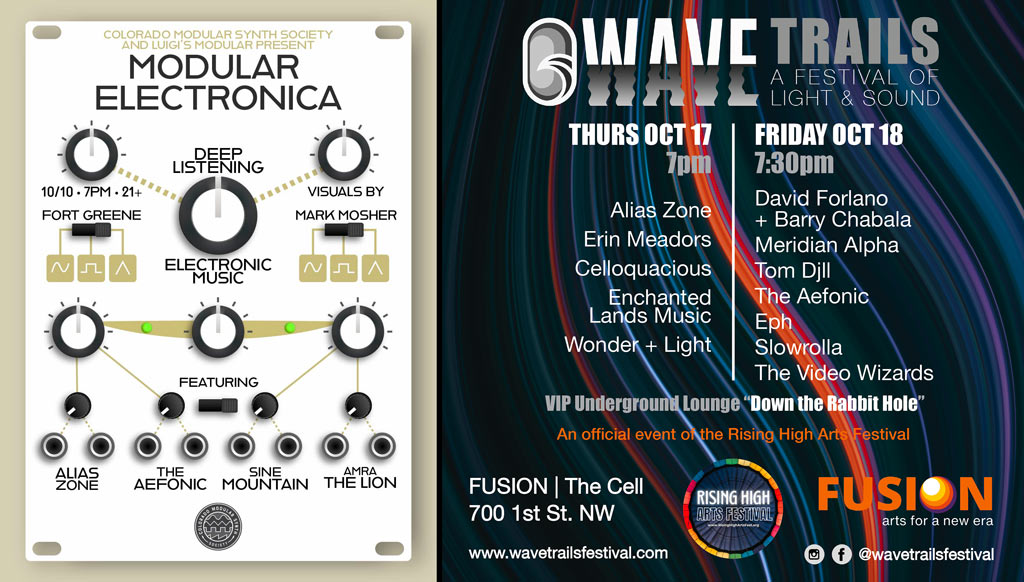Any thoughts on how someone can clone themselves? I used to think I was good at multitasking; I now admit I was just fooling myself. I need one version of me setting up the new studio I just moved into, another version working on my set for upcoming gigs, another working on my backlog of albums, and one more to share all of this with you.
Construction on my new studio is finally finished, and I love it; now I just need time to wire everything up, including sorting out some tricky long-distance USB problems that have been eating up far too much of my time (short version: powered hubs are good; female to female wall plate connectors are bad). I also love playing live, so I’ve also been spending a lot of time working on a new set and extending it for different length gigs. Plus I’m very excited about some new albums that I haven’t had time to work on. All while battling post-Knobcon Covid, and an arm I injured near the end of the construction (another tip: ease into a very heavy lift; don’t try to jerk it up). But, you just have to keep putting one foot in front of other and do what you can do, keeping in mind what both the goals and deadlines are for each task.
Things have calmed down enough that I was able to finally write another newsletter. In this issue I’m going to be talking about:
- featured article: Does it matter if the VCF or VCA come first in a patch? Yes! Here are a few different ways you might consider using VCAs in your audio signal flow.
- Alias Zone updates: I’ve composed a new long-form piece – Paradise Lost – and previewed it at the recently-passed Knobcon show. Here is the video of my performance.
- Learning Modular updates: Earlier this year NAMM interviewed me for the second time for their Oral History program. My first interview nearly 20 years ago focused on MIDI; this one focuses on modular synthesis.
- Patreon updates: I’ve been writing about updates to my performance system, a tricky patch on it to create more expressive noise splashes, and a Track Breakdown on my most recent performance using that case.
- upcoming events: In October I’m playing gigs in Denver and Albuquerque, with more on the horizon.
Which Comes First: the VCF or the VCA?
Is this the modular synthesis equivalent of the “which came first: the chicken or the egg” question? Not really…but it is a valid question worth discussing – because there is more than one answer, depending on what you’re trying to do.
The most common “East Coast” approach is to put the VCA after the VCF. Quite often, VCFs are noisier than VCAs – especially if the resonance (feedback) is turned up. For this reason alone, it is often a good idea to put the VCA after the VCF: to make sure a note dies away to actual silence when it is done.
However, there are other side effects from this choice. Some VCFs – as well as most other timbre modifier modules like wave shapers, wave folders, saturators, low pass gates, and more – sound different depending on how loud the signal is coming into them. In the VCF’s case, the issue is how much distortion they produce depending on how hard you drive them; if you are Patreon subscriber, see this article + video I created comparing the clipping characteristics of different filters I own.
Most traditional oscillators output a steady signal level. That means if the timbre modifier is between the oscillator and the VCA, and if you’re not changing parameters other than the VCA’s loudness, the resulting tone is going to stay the same as the VCA fades it up and down.
However, if you place the VCA before the timbre modifier, as you envelope, the VCA’s output level is going to change. This directly affects how hard you are driving the timbre modifier, dynamically changing the tone during the life of the VCA’s envelope. This is particularly true of filters that clip easily: The attack’s peak will have distortion, while the body of the note may not, creating a more aggressive “spitting” attack transient sound that works particularly well on percussion as well as struck & plucked sounds such as pianos. (For those who have done recording or live sound, this mimics the sound of overdriving a mixing board with a dynamic sound that is too hot.)
This VCA-before-timbre-modifier approach is less necessary if you have voltage control over how the timbre modifier bends the signal (I’m thinking of wave folders in particular), but even then it is worth testing to see if the result is different using an enveloped VCA in front compared to enveloping the CV inputs on the timbre modifier itself.
You don’t have to limit yourself to enveloped VCAs; you can also feed other control voltages such as aftertouch, velocity, or slow random sources to the VCA before the VCF or other timbre modifier to change the tone over time as well as the volume. If you use the bias or level control on the VCA or a utility mixer to keep its output level safely above silence, you can also use it as a expression control to change the tone with less of a change in volume. (This is where a mixer that can amplify the signal comes in handy when placed between the VCA and VCF; it gives you more overdrive range. The exponential option on some VCAs can also amplify signals.) You can then patch a second VCA after the VCF for normal volume enveloping.
It should also be noted that some VCAs – especially tube ones – can change tone as well as level as you vary their control voltage; now the VCA becomes its own timbre modifier. Placing it before the VCF allows you to then mellow out or focus on that distortion or other changes. Again, if you are a Patreon subscriber, I demonstrate a bit of that in this older post and audio recording.
VCAs before filters can also be used for dynamically mixing tones. The vintage RSF Kobol (functionally recreated in the Behringer Kobol Expander clone) has a VCA after each oscillator, which are then mixed and fed to the filter. This allows you to, say, envelope a higher-pitched or brighter VCO to give more of an attack transient; as it decays you hear the second VCO more prominently. As above, you can also use other modulation sources for the VCA’s level to turn it more into a expression control – such as using velocity to change the strength of one of the VCOs, or a slow envelope to bring in an undertone or a high feedback-like harmonic as you sustain the note.
With those last few suggestions, we have evolved from just switching the order of the VCF and VCA, to the old saying “you can never have enough VCAs” – but it’s true! An upcoming article I’m working on for my Patreon subscribers will focus on using VCAs to control modulation depths – not just audio. But that’s the beauty of using a modular synth: You can can try out these ideas that go beyond what the original designers thought of or intended.
Alias Zone Updates
Before my new studio was even completed, I set up my live system in it and started composing a new set for the Chill Out room at Knobcon in September, which is also going to be the core of my other gigs this winter. The result was a new piece: Paradise Lost. The video above is my inaugural performance of it at Knobcon, with computer graphics (including a LiDAR camera which created a 3D model of me in real time) by gordonswireworks and additional camera work by Nick Peck. The audio isn’t perfect – the mix captured more of the rear channels (I performed in quad) than the front, meaning some of the lead instruments are a bit buried – but overall it came off very nicely (with a lovely reaction at the end).
Learning Modular Updates
NAMM – the National Association of Music Merchants here in the US – has an Oral History program where they interview major figures in the industry. Back in 2005 they interviewed me for my role in the early years of MIDI, as well as why I left the industry; earlier this year they interviewed me about my return to the industry through modular synthesis, as well as range of other topics. Click on the second item in the list – “Chris Meyer Full Interview 2024” – to get the entire (new) story.
My modular synthesis courses are also still available online at courses.learningmodular.com. If you are relatively new to synthesis, the Basic Concepts course is free; if you are ready to start patching (either virtually in VCV Rack or with a hardware system), my Comprehensive Starter Course starts at ground zero with fundamental concepts and moves on to creating some of the more common patches and tricks. Whether you are a beginner or someone with experience but still a few gaps in your knowledge, you’ll find it helpful. And finally, if you’re a more experienced user and are looking for some patch ideas, check out Eurorack Expansion, and learn how just a single module can open up new possibilities. All courses come with a money back guarantee – so what do you have to lose?
Patreon Updates
My Patreon subscription has evolved over the years from additional module reviews and bits of nostalgia to now covering studio and composition techniques in addition to advanced patching ideas. There are roughly 500 posts in the archives now, all of which you get access to from day one of your subscription at the +5v level or higher, including during the seven day free trial.
New posts I’ve written since the last newsletter include:
- Optimizing the Layout of a Modular Case for Live Performance, where I walk through decisions on mobile placement and even panel color to make my modular system more user-friendly during the panic of a gig.
- Adding Expressiveness to LPGs (or, Making More Interesting Noise Splashes): building a patch to recreate the classic “noise splash” percussion effect, and then extending it to create more variety on every hit – with audio examples.
- Improving My Live Performances pt. 5: 2024 Module Updates where I go into detail about modules I’ve added and removed since my last set of gigs, and the reason each one came or went.
- Track Breakdown: Paradise Lost (first live performance) where I give a blow-by-blow of what I’m doing at each stage of the piece, including patch details, samples or software synths used, composition ideas, and even what went wrong.
All of the above posts are for +5v level and above subscribers. (Did I mention there is a seven day free trial?)
Upcoming Events
October 10, 7 PM, Fort Greene Bar, Denver Colorado
This is the inaugural Modular Electronica event at Fort Greene Bar is being staged by the Colorado Modular Synth Society with help from Luigi’s Modular Supply. Performers will include (in order) Amra the White Lion, Sine Mountain, The Aefonic, and myself. The evening will have a downtempo/ambient groove/deep listening vibe, where you can get close to the musicians. Admission is free.
If you are in Denver for our show, stick around a couple of nights and make sure you check out Steve Roach’s 40 Years of Silence concert in Denver on Saturday, October 12 – I will be in attendance as well!
October 17, 7 PM, FUSION | The Cell, Albuquerque New Mexico
The first night of the Wavetrails Festival – part of the larger Rising High Arts Festival happening October 10-20 at FUSION Theatre in Albuquerque – will feature music, motion-activated dance, and more all happening inside a four-walled cube of animated graphics. I will be going on after the intermission, around 8-8:30. Ticket options include an all-music program Friday night and access to a VIP chill-out lounge.
January 23 2025, 6 PM, Radiant Beer Company, Anaheim California
The Southern California Synth Society puts on an annual Electronic Sonic Madness show during NAMM week for primarily modular synthesis acts, with a long list of performers, free admission, and lots of giveaways. I will be playing an extended “kick off” set when the doors open at 6 PM.
Some of you may remember I was scheduled to play a gig September 14 with Michael Stearns at the Paradiso in Santa Fe, New Mexico. That had to be postponed due to schedule conflicts; we’re hoping it get re-scheduled for early 2025.
I’m really enjoying spending time in my new studio, even though a lot of work remains to get it fully functional. It’s really nice to be able to create a customized creative space for yourself; every time I settle down to work in here, my heart and breathing rates lower, and I’m more creative and productive. I hope each of you can also find your own creative space, even if it’s just a corner of your mind.
looking forward –
Chris

